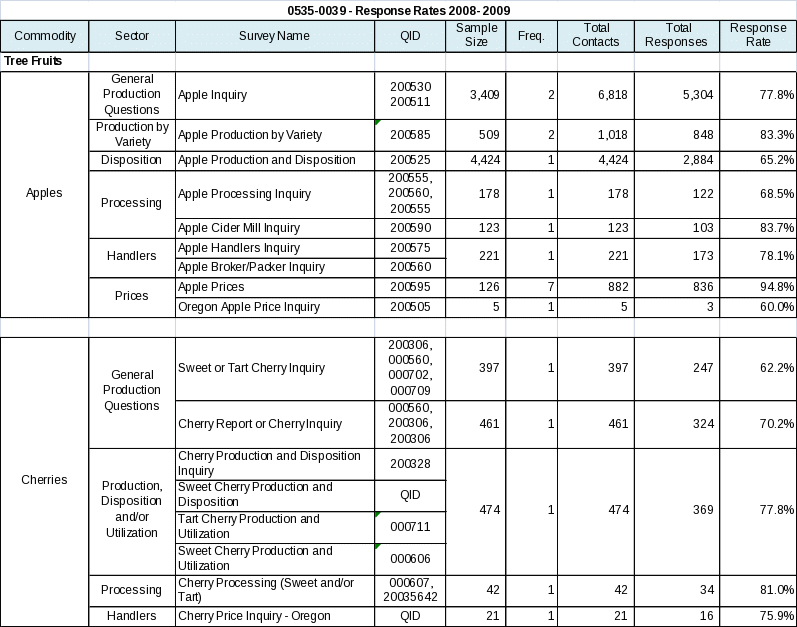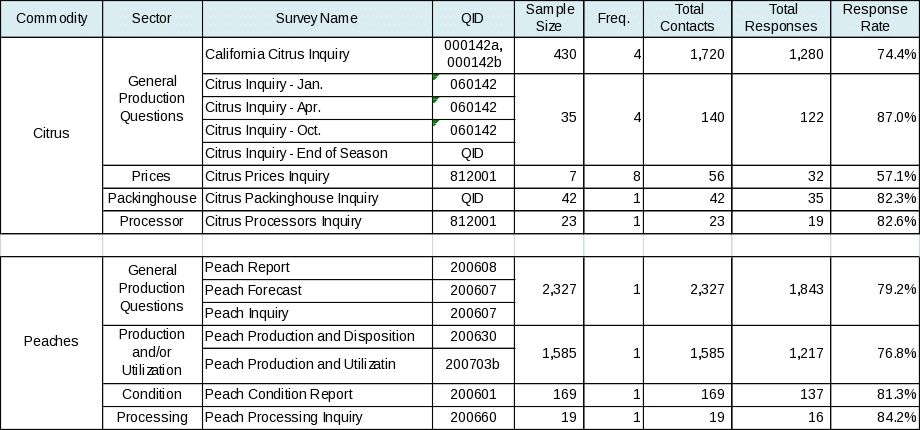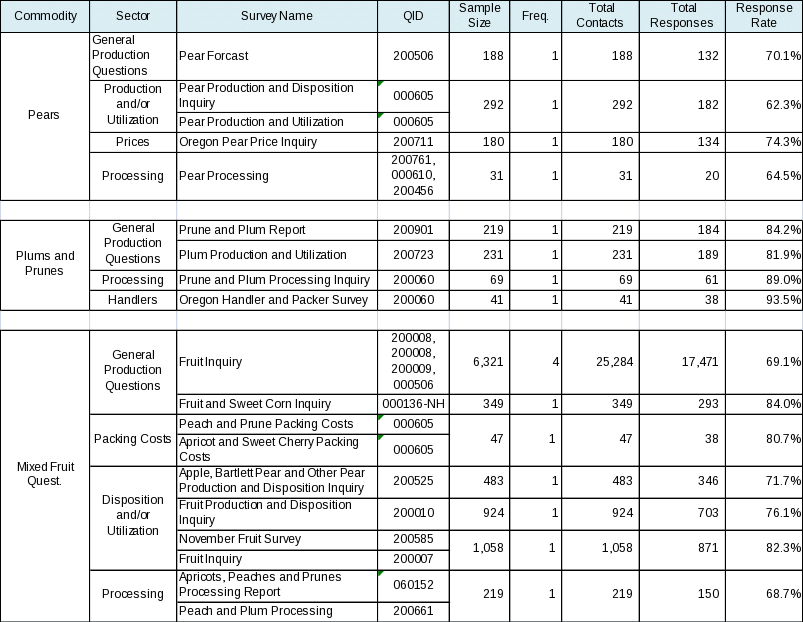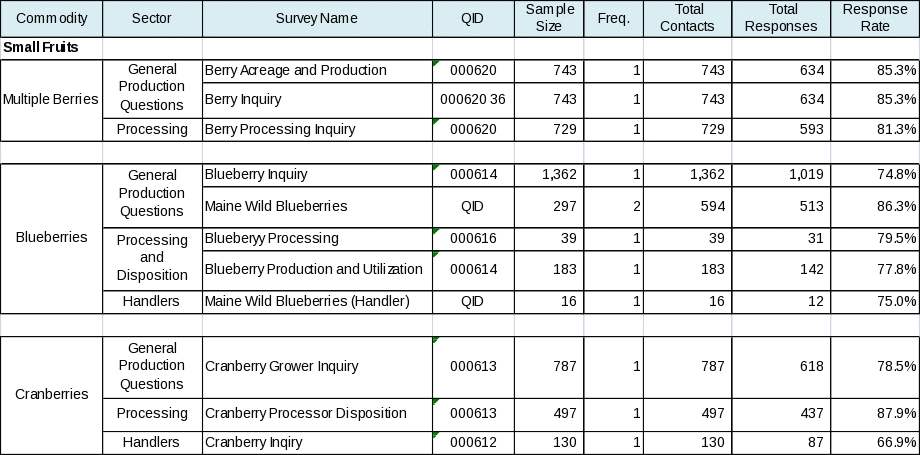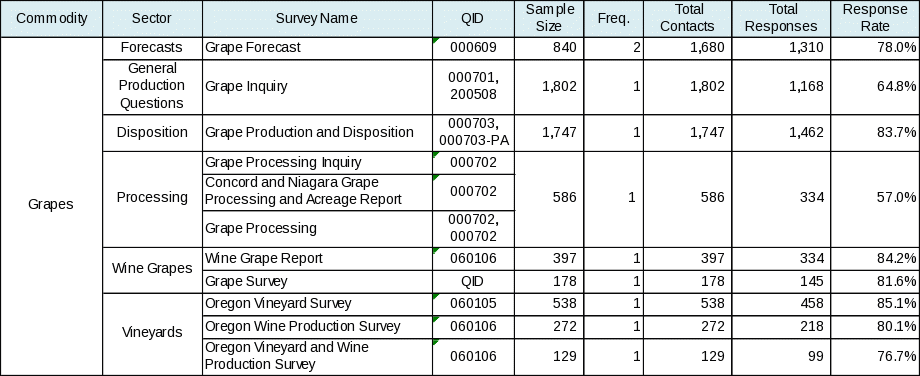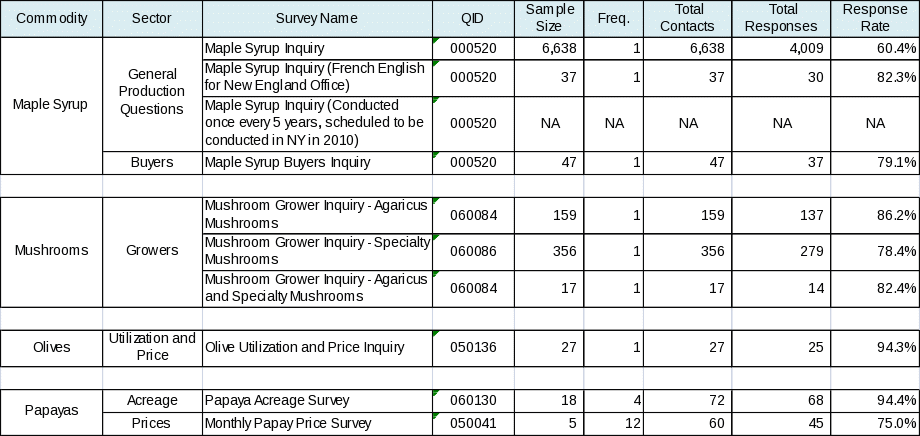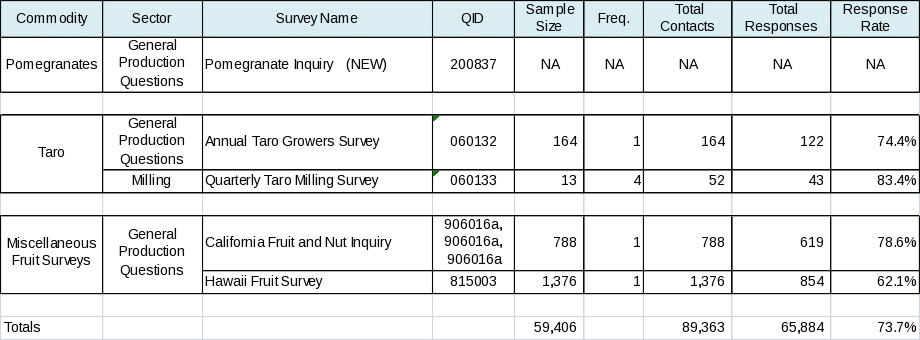0039-fruitnut-10-SSB
0039-fruitnut-10-SSB.doc
Fruit, Nuts, and Specialty Crops
OMB: 0535-0039
Supporting Statement - Part B
FRUIT, NUTS, AND SPECIALTY CROPS
OMB No. 0535-0039
B. COLLECTION OF INFORMATION EMPLOYING STATISTICAL METHODS
1. Describe (including a numerical estimate) the potential respondent universe and any sampling or other respondent selection method to be used. Data on the number of entities (e.g., establishments, State and local government units, households, or persons) in the universe covered by the collection and in the corresponding sample are to be provided in tabular form for the universe as a whole and for each of the strata in the proposed sample. Indicate expected response rates for the collection as a whole. If the collection has been conducted previously, include the actual response rate achieved during the last collection.
According to the 2007 Census of Agriculture, there are just over 247,000 farm operators producing fruits, nuts and/or specialty crops in the United States. The potential respondent universe is approximately 150,000 growers in States with significant commercial production of fruits, nuts, and specialty crops. Complete enumerations of fruit, nut, and specialty crop brokers, buyers handlers, packers, processors, shellers, and shippers (depending on the crop) are conducted because of the small number of firms involved and the significant difference in kind and quantity of product handled. Complete enumerations are also attempted of growers for several of the specialty crops such as coffee, ginger root, grapes (in small production States), hops, all commercial mushroom growers, papayas, and taro. Orchard and vineyard inventory surveys are also conducted as a complete enumeration in order to obtain control data to use in drawing samples for monthly or quarterly production forecasts.
Samples for the monthly fruit and nut inquiries are selected to represent all fruit areas in the target States. Phone and field follow-up contacts for non-respondents are primarily directed at the larger producers. This helps to insure a high level of coverage for each commodity while reducing data collection costs.
Following the Census of Agriculture, conducted by NASS every five years, our Statistics Division reviews all commodities and makes adjustments as to which States are included in the samples each year. States that are no longer a major player in a particular commodity will be dropped from the program for that commodity.
Any specialty commodity that is identified by the Census of Agriculture can also be added to the data collection process. Due to the increase in number of producers of pomegranates, we have added them to this docket request to add them as a new survey.
Response rates for 2008 - 2009 are shown in the table below.
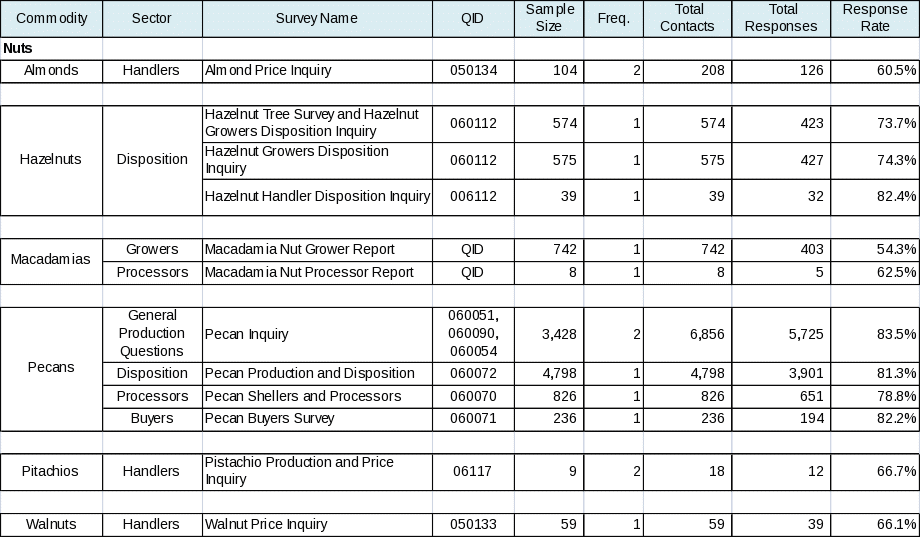
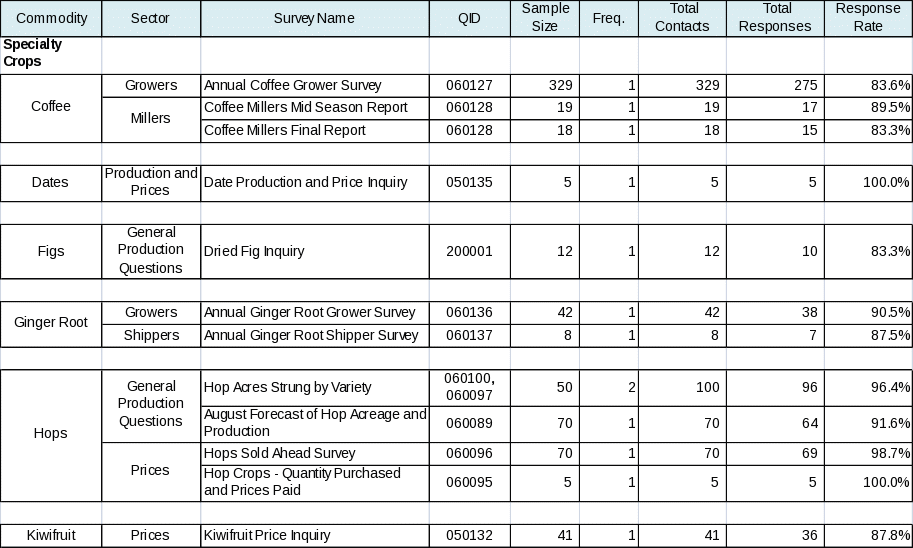
2. Describe the procedures for the collection of information including:
• statistical methodology for stratification and sample selection,
• estimation procedure,
• degree of accuracy needed for the purpose described in the justification,
• unusual problems requiring specialized sampling procedures
Overview - With all NASS surveys, the goal is to collect data from at least 80% of the records sampled and more importantly, achieve coverage for at least 80% of the production data or production area. We utilize mail, phone and personal interviews to collect data. In our ongoing effort to collect quality data in a timely and economic manner, NASS utilizes the mail as the first method of data collection with selected phone or personal interview follow up for non-response. With limited funds for extensive data collection, phone and field enumeration is targeted for the larger operations that will help achieve 80% coverage of production or production area.
Low Response Rates - With surveys that have persistently low response rates, NASS looks for alternative ways of collecting the data; particularly sources of administrative data. In instances where these data provide sufficient coverage and accuracy, we consider the opportunity to discontinue collections and reduce burden.
Sampling - Most fruit, nut, and specialty surveys are non-probability surveys selected to represent and provide coverage for fruit, nut and specialty crop producing regions of each State. Samples are selected based on acreage control data to ensure coverage of all size operations.
3. Describe methods to maximize response rates and to deal with issues of non-response. The accuracy and reliability of information collected must be shown to be adequate for intended uses. For collections based on sampling, a special justification must be provided for any collection that will not yield "reliable" data that can be generalized to the universe studied.
Field Office staff routinely visit producers and industry organizations to promote the program and importance of cooperating. NASS maintains a presence at National industry meetings, often setting up promotional booths at trade shows. Occasionally, letters of endorsement are obtained from industry leaders. Most States conduct a full non-response follow up.
Some of the specialty surveys may have only a few respondents who account for a majority of the data for that given commodity. State Field Offices, in their efforts to reduce respondent burden as well as reduce the costs of data collection will concentrate their data collection efforts on the major producers for each of the commodities. Questionnaires are mailed out to the smaller respondents with minimal follow up. The information received in the mail is used to update control data as well as help States to establish the number of growers for each of the commodities. However, in most cases the total production, prices, area in production, etc. are estimated from data received from the larger operations. More importantly than getting the 80% good response rate for each survey, States strive to get greater than 80% coverage of data for all surveys.
As mentioned in the Supporting Statement Part A, justification, NASS is undertaking several new initiatives to improve all aspects of the NASS mission statement. This will include the continued development and improvement of Electronic Data Reporting (EDR) tools. This will give farm operators the flexibility to respond whenever it is convenient for them and should result in higher response rates in the future.
4. Describe any tests of procedures or methods to be undertaken.
All data collections follow standardized procedures to ensure accurate estimates. Check data are available for most of the crops after the marketing season ends.
5. Provide the name and telephone number of individuals consulted on statistical aspects of the design and the name of the agency unit, contractor(s), grantee(s), or other person(s) who will actually collect and/or analyze the information for the agency.
Sample sizes for each State are reviewed by the Agency's Statistical Methods Branch, Statistics Division; Branch Chief is Dave Aune, (202)720-4008.
Data collection is carried out by NASS Field Offices; Deputy Administrator for Field Operations is Marshall Dantzler, (202)720-8220.
Estimates are compiled and reviewed by the Agency’s Statistics Division, Crops Branch; Branch Chief is Lance Honig, (202)720-2127.
Survey data are collected, reviewed, and summarized by the State Field Offices. Publications are released from the State Offices and Headquarters.
January, 2010
| File Type | application/msword |
| Author | David Hancock |
| Last Modified By | David Hancock |
| File Modified | 2010-01-28 |
| File Created | 2009-12-30 |
© 2026 OMB.report | Privacy Policy
